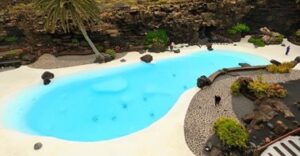
Blog # 9 Summer lovin’ in Lanzarote…kind of
I’m not one for FOMO (fear of missing out) but in the past few days, that’s precisely what I’ve had. Last week, NECSTouR and SPEL-Turismo Lanzarote have hosted a three-day gathering called Empowering Destination Leaders to Deliver Sustainability.
The event focused on three major common challenges to tourism destinations: reducing seasonality, measuring tourism carbon footprint and fostering tourism’s climate action.
The gathering also hosted speakers Xavier Font and Anna Torres Delgado from the University of Surrey, which means in my books, it’s got a trifecta of things I am deeply passionate about; Brits (I can’t help it, as an ex-pat, sometimes I just miss them!), sustainable tourism, and Lanzarote.
In addition to the desperate stab of jealousy I had of those attending, reading about this fantastic conference made me oddly nostalgic. For me, Lanzarote was one of the first chapters in my story as a business and events tourism professional.
Landing in Lanzarote
Twenty years ago, I left university with a BA Honours in Service Sector Management and Tourism, and immediately signed up for a job that required zero tertiary education whatsoever.
Odd choice on the surface, but I knew I had to get out into the world I was so desperate to explore, and an office job at Thomas Cook just wasn’t going to cut it.
Instead, I found myself working as a Villa Rep with a tour company, thriving off the opportunities and learnings it gave me, thoroughly thrown into the deep end. Lanzarote was my second assignment, and as soon as I arrived, I was given my first challenge; to drive a car on the wrong side of the road (now in Canada, I’m grateful for the practice!) across an island I was clueless about, with no GPS, no cell phone, and a tattered old map.
I had two days to job shadow my predecessor, and, as I was told, it was lucky that I also had blonde hair, as I’d be playing the role of Sandy in the Rep Entertainment show.

I thrived in my work, but if I’m honest, I wasn’t in love with Lanzarote at first, it took time to grow in my affection. The areas we were in felt cookie cutter and I wasn’t getting to know any locals, as there was a definite barrier between them and who they served, even though I was on the service side of things myself! But over time, and with some work, things began to change.
Living in Lanzarote
My first step was going to church. I was Catholic and went to mass on the island at Christmas. It was my earliest taste of what local life was like. I stood in the doorway of the packed little chapel, breathing in the incense, and though I couldn’t understand a word of the mass, I felt connected to something in Lanzarote for the first time. It was beautiful.
Next, some friends and I went south on the island to a local festival at the Playa Blanca, where there was proper local music. Everyone was dancing and having the best time, and I loved it!
I started to see things on the island that were unique; it’s a tiny, flat island with extremely strong wind, but they manage to work around these challenges to grow the most amazing grapes. They’ve built special half-moon stone walls to protect the vines. The soil is volcanic, so it’s nutrient-rich, and as long as the grapes aren’t blown to smithereens, they’re wonderful.

I learned about César Manrique, a renowned local artist, and went to see his home, which itself is a work of art. I even visited Jameos del Agua; the first of the Art, Culture and Tourism Centers created by Manrique in Lanzarote, and the venue of the NECSTouR event.

The beautifully-designed space represents artistic harmony with the environment, which, both twenty years ago and now, is what Lanzarote strives for.
Learning from Lanzarote
For decades, Lanzarote has led the way for sustainable tourism, launching the Charter for Sustainable Tourism in 1995 to call on governments, public authorities, and key players in tourism to:
“Recogni[se] the need to develop a tourism that meets economic expectations and environmental requirements, and respects not only the social and physical structure of destinations, but also the local population.”
Unlike other tourist destinations, Lanzarote isn’t filled with high-rise hotels; the majority of buildings are low-slung and painted in the traditional Canarian whitewashed style with green accents. This is also down to Manrique, who lobbied for height and colour restrictions to be used on buildings to preserve the traditional feel of the island. It’s still against the law to paint your house anything other than white or beige!
Today, the island has a network of sustainable accommodation with a focus on sustainable tourism that respects the environment, culture, and socio-economic development of Lanzarote.
Essentially, this NECSTouR and SPEL-Turismo Lanzarote event on sustainability is simply one more thing for this island to boast about. And perhaps one more reason for me to mark next year’s calendar for some bleisure travel …

